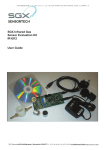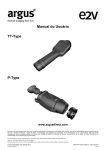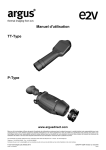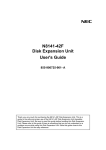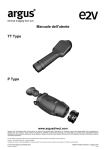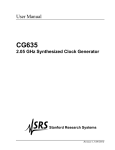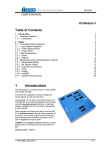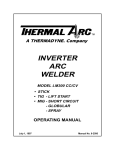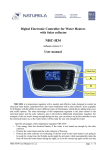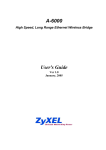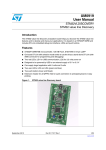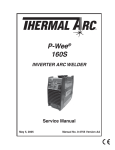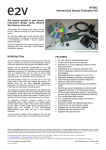Download e2v Metal Oxide Semiconductor (MOS) Gas Sensor
Transcript
e2v Metal Oxide Semiconductor (MOS) Gas Sensor Evaluation Kit MICS-EK1 User Guide Whilst e2v technologies has taken care to ensure the accuracy of the information contained herein it accepts no responsibility for the consequences of any use thereof and also reserves the right to change the specification of goods without notice. e2v technologies accepts no liability beyond the set out in its standard conditions of sale in respect of infringement of third party patents arising from the use of tubes or other devices in accordance with information contained herein. e2v technologies (uk) limited, Waterhouse Lane, Chelmsford, Essex CM1 2QU United Kingdom Holding Company: e2v technologies plc Telephone: +44 (0)1245 493493 Facsimile: +44 (0)1245 492492 Contact e2v by e-mail: [email protected] or visit www.e2v.com for global sales and operations centres. © e2v technologies (uk) limited 2010 Template: DF764388A-3 DAS766841AA Version 2, February 2010 108014 IMPORTANT INFORMATION Before using this product, please read and understand all the instructions and warnings. e2v technologies does not accept responsibility for damage or injury resulting from failure to follow the instructions provided. WARNINGS • The Evaluation Kit is despatched from e2v technologies in a safe condition. Any unauthorised modifications may compromise safety and invalidate the warranty. • The supplied power supply adapter is double insulated, indicated by the double square symbol. If the Evaluation kit is used with a power supply which is not double insulated, connect a Protective Earthing Connection to the Protective Earth terminal on the PCB indicated by the Protective Earth symbol in case of power supply faults. • The Evaluation Kit is not certified as intrinsically safe and therefore must not be operated in potentially flammable or explosive atmospheres. • Neglecting the above may result in injury or death. CAUTIONS • The Evaluation Kit is intended for engineering development, demonstration or evaluation purposes only. It is not considered to be suitable for general consumer use and should be handled by people with suitable electronics training. • The Evaluation Kit contains electrostatic discharge sensitive devices. Always observe handling precautions. • The Evaluation Kit and MOS Gas Sensor Devices should always be used within their ratings as given in their data sheets. COMPLIANCE • The Evaluation Kit is intended for engineering development, demonstration or evaluation purposes only and not for sale on the open market. • This Evaluation Kit has been tested (but not certified) and deemed to comply with the limits for a Class B digital device, pursuant to part 15 of the FCC Rules and European Union directives on electromagnetic compatibility. These limits are designed to provide reasonable protection against harmful interference when the equipment is operated in a commercial environment. This equipment generates, uses, and can radiate radio frequency energy and if not installed and used in accordance with the instruction manual, may cause harmful interference to radio communications. The user is responsible for providing reasonable protection against interference with other electronic equipment. • The Evaluation Kit is not intended for automotive use. It does not contain protection devices against vehicle supply transient voltages and must not be used for the control of a vehicle, a vehicular safety system or in a way that may disturb the driver, data bus or statutory devices fitted to a vehicle. ENVIRONMENTAL • e2v technologies declares that the Evaluation Kit complies with EC directive 2002/95/EC (the RoHS Directive) restricting the use of certain hazardous materials in electrical and electronic equipment. See section 16 for China RoHS information. • The Evaluation Kit is classified as Electronic and Electrical Equipment according to directive 2002/96/EC (the WEEE Directive) and should be segregated from domestic waste for disposal. Contact your local e2v sales office for disposal instructions. © e2v technologies (uk) limited 2010 Document subject to disclaimer on page 1 DAS766841AA Version 2, page 2 Contents 1 2 3 4 5 Introduction ......................................................................................................................................... 4 Quick Start Guide ............................................................................................................................... 5 Using the e2v Data Logging Software ................................................................................................ 7 Using HyperTerminal .......................................................................................................................... 9 User Interfaces, Controls and Indicators .......................................................................................... 11 5.1 5.2 5.3 5.4 5.5 5.6 5.7 6 Power Supply (SK4, TB1)..............................................................................................................................11 Gas Sensors Sockets (SK1, SK2) .................................................................................................................11 Control Switch (SW1) ....................................................................................................................................11 JTAG Port (PL1) ............................................................................................................................................11 Expansion Port (PL2).....................................................................................................................................12 LEDS (D1, D2, D3, D4, D5) ...........................................................................................................................12 Reset Switch (SW2).......................................................................................................................................12 Heater Control .................................................................................................................................. 13 6.1 6.2 6.3 7 Introduction ....................................................................................................................................................13 Software Control of Heaters ..........................................................................................................................14 Multiple Power Levels....................................................................................................................................15 Sensor Resistance Measurement..................................................................................................... 16 7.1 7.2 8 Introduction ....................................................................................................................................................16 Software Control of Sensors..........................................................................................................................17 Temperature and Humidity Measurement ........................................................................................ 18 8.1 8.2 9 Temperature Measurement ...........................................................................................................................18 Humidity Measurement..................................................................................................................................18 Alarm Outputs and LEDs .................................................................................................................. 19 9.1 9.2 9.3 10 10.1 10.2 11 11.1 11.2 12 13 14 15 16 17 Introduction ....................................................................................................................................................19 Software Control of Alarm outputs.................................................................................................................19 Additional Alarm Function..............................................................................................................................20 Digital Inputs ................................................................................................................................. 21 Introduction................................................................................................................................................21 Software Reading of Digital Inputs ............................................................................................................21 Analog Outputs ............................................................................................................................. 22 Introduction................................................................................................................................................22 Software Control of Analog Outputs..........................................................................................................22 Appendix: Evaluation Kit PCB Schematic Diagram ...................................................................... 23 Appendix: Evaluation Kit PCB Parts List ...................................................................................... 24 Appendix: SMD Adapter PCB Schematic and Legend ................................................................. 25 Appendix: Serial Message Protocol .............................................................................................. 26 Appendix: China RoHS Declaration.............................................................................................. 28 Appendix: Updating the MICS-EK1 Embedded Software ............................................................. 29 © e2v technologies (uk) limited 2010 Document subject to disclaimer on page 1 DAS766841AA Version 2, page 3 1 Introduction Thank you for purchasing the e2v Metal Oxide Semiconductor (MOS) Gas Sensors Evaluation Kit. e2v MOS Gas Sensors are low power, low cost devices capable of detecting a range of gases. These devices can be used in many different applications and this Evaluation Kit from e2v will allow you to experiment and find the most suitable mode of operation for your particular use. This Evaluation Kit allows you to: • • • • • • • • Test two leaded sensors or one single/dual surface mount sensor* Set the heater powers to two preset levels, or change these levels for your application using plugin resistors. Measure the sensor resistance and ambient temperature. Set four alarm levels (2 per channel) which drive on-board LEDs and open collector outputs. Measure relative humidity by fitting a humidity sensor (not supplied). Drive two analogue outputs Connect additional circuits to an expansion port Log sensor outputs, temperature and humidity using the supplied PC Data Logging Program. *Adapter PCBs are required to enable a single or dual surface mount sensor to be plugged into the pair of sensor sockets on the Evaluation Kit. These are available in packs of 5 from e2v or a distributor, part number MICS-SMD-PCB5. Contents of Evaluation Kit • • • • Evaluation PCB Mains Power Adapter USB Lead CD containing User Manual, e2v Data Logging Software and USB Drivers © e2v technologies (uk) limited 2010 Document subject to disclaimer on page 1 DAS766841AA Version 2, page 4 2 Quick Start Guide 1. Read the Manual! The supplied CD should auto-run on your PC when inserted into a CD drive. Select ‘User Guide’ from the CD menu. Before using this product, please read and understand all the instructions and warnings. e2v technologies does not accept responsibility for damage or injury resulting from failure to follow the instructions provided! 2. Install the e2v Data Logging Software & USB Drivers on your PC Select ‘Install Data Logging Software and USB Drivers’ from the CD menu. Follow the on-screen instructions. 3. Set up the Evaluation PCB a. Plug one or two e2v MOS Gas Sensors into SK1 and/or SK2 on the Evaluation PCB. Ensure the orientation tab on the sensor matches the tab on the socket. b. Set SW1 on the PCB as follows: • SW1-1 and SW1-2: The Evaluation Kits are initially set in ‘automatic heater mode’ for driving low power sensors. For high power sensors, override this mode and force the heater power to continuous high power mode as follows: SW1-1 ON - for high power sensor in SK1 (see over for diagram & sensor list) SW1-2 ON - for high power sensor in SK2 (see over for diagram & sensor list) • SW1-3 Off • SW1-4 Off c. Connect the supplied USB lead from SK5 to a USB socket on your PC 4. Connect the 9 V Power Supply Unit a. Connect the DC output of the Power Supply Unit to SK4 b. Slide the correct pinned mains adapter to the Power Supply Unit to suit the mains sockets in your country. Plug in the Power Supply Unit. Green LED D5 should be flashing. Other LEDs may also come on. c. The PC may take a minute to recognise and initialise the new hardware drivers. 5. Run the e2v Data Logging Software a. Run the program from the start menu. b. The software will automatically detect which ‘Com Port’ is being used for the USB connection. (If this does not happen, a Com Port can be manually selected by unticking ‘Automatically search for connected device’ on the ‘Hardware’ menu. c. The outputs of the Evaluation Kit will now be displayed on the PC monitor. Congratulations! You are now evaluating e2v Metal Oxide Semiconductor Gas Sensors. Please refer to the full User Guide on the CD for more detailed instructions © e2v technologies (uk) limited 2010 Document subject to disclaimer on page 1 DAS766841AA Version 2, page 5 Quick Start Guide (Continued) Basic Interfaces and Controls of Evaluation Kit SK5 SK1 1 2 3 OFF 4 SW1 SW1 SK2 D5 USB To PC 9V DC From PSU SK4 ON Using MICS Sensors with the Evaluation Kit Leaded Sensors Automatic operation: SW1-1 (if fitted in SK1) SW1-2 (if fitted in SK2) ON ON OFF ON ON ON ON ON Part No. Type Gases Power MICS-2610 MICS-2611 MICS-2710 MICS-5121 MICS-5132 MICS-5135 MICS-5521 MICS-5525 Leaded Single Leaded Single Leaded Single Leaded Single Leaded Single Leaded Single Leaded Single Leaded Single Ozone Ozone NO2 CO/HC/VOC CO/HC/VOC CO/HC/VOC CO/HC/VOC CO/HC/VOC High High Low High High High High High Part No. Type Gases Power SW1-1 SW1-2 MICS-2614 SMD Single ON* SMD Dual ON ON MICS-2714 SMD Single OFF OFF* MICS-4514 SMD Dual OFF ON MICS-5134 MICS-5524 MICS-5914 SMD Single SMD Single SMD Single High High High Low Low High High High Medium ON MICS-4614 Ozone Ozone Ozone NO2 NO2 CO/HC/VOC CO/HC/VOC CO/HC/VOC NH3 ON ON ON** ON* ON* ON* SMD Sensors *Not critical as sensor position is empty **Change Rb to 93.1R (E96 series resistor, not supplied) to operate at 66mW Evaluation Kit Default Power Levels: • High Power: 76 mW • Low Power: 43 mW © e2v technologies (uk) limited 2010 Document subject to disclaimer on page 1 DAS766841AA Version 2, page 6 3 Using the e2v Data Logging Software Follow the instruction in the Quick Start guide to get the software operating. The screen should appear as follows: The USB interface to the Evaluation Kit appears as a virtual ‘Com Port’. When the program is started the software will automatically detect which ‘Com Port’ is being used for the USB connection. (If this does not happen, a Com Port can be manually selected by unticking ‘Automatically search for connected device’ on the ‘Hardware’ menu. The Com Port can be manually selected, using trial and error to identify the correct one. This is also useful when multiple Evaluation Kits are being used on one PC. The main screen gives a continuous display of sensor resistances, temperature and optionally humidity (when a humidity sensor is fitted). The graph view can be changed to display all these parameters in real time. The data can also be saved to a file in ‘csv’ format which can be read by most spreadsheet programs. Note that many spreadsheets will read a maximum of 65536 lines (18 hours of data at 1 second intervals). The measurement period can be increased from 1 second to allow longer tests to be imported. For example, a 10 second measurement period allows 7.5 days of data to be read into a spreadsheet. By default, the data logging software autoscales the output readings (i.e. the graph axes expand to show all of the readings on y and x axes). However, it is possible to change these values in order to ‘zoom in’ on certain readings. © e2v technologies (uk) limited 2010 Document subject to disclaimer on page 1 DAS766841AA Version 2, page 7 In the Data Logging tab, right-click on the graph to be adjusted and untick ‘autoscale’ for the avis you want to change: This stops the axis from automatically expanding. The values in the axis can then be changed. To do this, double-click on the value at one end of the axis and adjust using the keypad. The ‘Alarms’ tab allows setting of alarm thresholds, described in section 9. The ‘I/O’ tab gives allows monitoring of digital inputs (see section 10) and setting of analog outputs (see section 11). The ‘Advanced’ tab allows setting of the heater drives (see section 6) and also manual control of the output load resistance for measurement (see section 7). The ‘Hardware’ menu contains an Update Firmware feature which allows software updates to be loaded into the microprocessor without having to return the PCB to e2v for reprogramming. This feature should only be used with direct instructions from e2v. © e2v technologies (uk) limited 2010 Document subject to disclaimer on page 1 DAS766841AA Version 2, page 8 4 Using HyperTerminal The e2v Data Logging software provides full control and monitoring of all the operation modes of the Evaluation Kit. However users may wish to communicate using the low level protocol. This can be done manually using a terminal emulation program such as HyperTerminal, or by writing your own PC software using a language such as Visual Basic or Labview. The low level message protocol is given in the appendices to this manual. To communicate with the Evaluation Kit using HyperTerminal use the following procedure: (Note: the USB Drivers must be installed.) • Run HyperTerminal from the Windows Start button • Enter a name and choose an icon: • Select the correct ‘COM Port’ being used by the USB Driver: • Select 9600 Bits per second (Baud), 8 data bits, no parity, 1 stop bit, no flow control: © e2v technologies (uk) limited 2010 Document subject to disclaimer on page 1 DAS766841AA Version 2, page 9 • Select File/Properties. Click the Settings tab, then the ASCII Setup button. Ensure ‘Echo typed characters locally’ is checked: • Type [WHO] and a response should be received from the Evaluation Kit Further HyperTerminal commands are described throughout this manual. A complete list is given in the appendices. © e2v technologies (uk) limited 2010 Document subject to disclaimer on page 1 DAS766841AA Version 2, page 10 5 User Interfaces, Controls and Indicators 5.1 Power Supply (SK4, TB1) The Evaluation Kit requires a 9V +/-10% power supply. Either connect the supplied 9 V DC mains adapter to SK4 or a 9 V ± 10% laboratory supply to the terminal block TB1. The supplied power supply adapter is double insulated, indicated by the double square symbol. If the Evaluation kit is used with a power supply which is not double insulated, connect a Protective Earthing Connection to the Protective Earth terminal on the PCB indicated by the Protective Earth symbol in case of power supply faults. 5.2 Gas Sensors Sockets (SK1, SK2) Gas sensors should be plugged into SK1 and SK2. Be careful to ensure that the orientation tab on the sensor matches the marking on the circuit board. A dual surface mount sensor can be testing using an adapter PCB from e2v. The adapter PCB should be plugged into both SK1 and SK2. Be careful to ensure that the PCB is fitted in the correct orientation by observing the corner markings. 5.3 Control Switch (SW1) SW1 should normally be all off. Other settings allow use of special modes: SW1 1 2 3 4 Off Normal: SK1 fully controlled by micro Normal: SK2 fully controlled by micro Normal: SK1 and SK2 independent Normal: Humidity sensor not fitted On Force high power mode for SK1 Force high power mode for SK2 Multi-level single sensor mode Humidity sensor fitted SW1-1 and SW1-2 may be set ON for CO, VOC and Ozone Sensors to only run these sensors at higher power. This can be useful if the heater drive is set to automatic (see Heater Control). SW1-3 may be set to ON for multi-level single sensor mode. Only one sensor should be fitted (either SK1 or SK2 but not both) and different heater drive resistors are required. This mode uses the heater drives in parallel on a single sensor to give more levels of heater power for experimental purposes. SW1-4 may be set to ON when the user has fitted a humidity sensor in position S1. In this case the temperature readings are also taken from the humidity sensor rather than the LM60 IC as this gives slightly improved accuracy. 5.4 JTAG Port (PL1) The JTAG Port can be used by engineers wishing to develop their own software for the Evaluation Board. The socket will connect to a Texas Instruments MSP430 Debug Interface, e.g. MSP-FET430UIF, for reprogramming and debugging. TDO TDI TMS TCK 0V TRST Unused 1 3 5 7 9 11 13 2 4 6 8 10 12 14 © e2v technologies (uk) limited 2010 VCCO VCCI Unused Unused Unused Unused Unused Document subject to disclaimer on page 1 DAS766841AA Version 2, page 11 5.5 Expansion Port (PL2) PL2 is an expansion port allowing connection to additional peripherals. The port provides access to the input and 3.3 V supplies, four open collector outputs, four digital inputs, two analogue outputs and a spare UART connection. 3V3 Regulated Power 0V Input 1 (3V3 logic) Input 2 (3V3 logic) Input 3 (3V3 logic) Input 4 (3V3 logic) 0VA 0VA Serial RXD (3V3) 0V 5.6 1 3 5 7 9 11 13 15 17 19 2 4 6 8 10 12 14 16 18 20 9V Unregulated Power 0V Output 1 (Open collector) Output 2 (Open collector) Output 3 (Open collector) Output 4 (Open collector) Analogue Output 1 (0 to 2.048V) Analogue Output 2 (0 to 2.048V) Serial TXD (3V3) Not used LEDS (D1, D2, D3, D4, D5) D1, D2, D3 and D4 indicate the state of each open collector output on the Expansion Port. D5 flashes to indicate that the power is on and the software is operating normally. 5.7 Reset Switch (SW2) Press and release SW2 to reset the microcontroller. This has the same function as removing and reconnecting the power supply. PCB Layout: © e2v technologies (uk) limited 2010 Document subject to disclaimer on page 1 DAS766841AA Version 2, page 12 6 Heater Control 6.1 Introduction Ozone and CO/VOC sensors are normally driven at about 76 mW. NO2 sensors require only 43 mW, but when first turned on, they will stabilise faster if driven at the higher power for about 90 seconds. It is also useful to overdrive them at the higher power once every 24 hours in order to burn off any build-up of airborne pollutants. The temperature rise of the heaters is proportional to the applied power. When operated at higher temperatures for extended periods of time, some positive drift of the heater resistance will be experienced. In order to keep the heater power constant as the resistance varies, a simple constant power circuit is used comprising of a 5 V bias with a balance resistor. At lower powers the heater resistance drift is minimal. The Evaluation Kit allows each heater to be controlled independently. The heater drives can be set to high power, low power, off, or automatic 24 hour cycle. SW1-1 and SW1-2 on the PCB can be used to override low power mode, forcing heaters 1 and 2 respectively to be either high power or off. This can be useful if the Evaluation Kit is set-up for ‘automatic’ but you want to experiment with different types of sensor. High power is set at 76 mW and low power at 43 mW using plug-in resistors. Other powers can be set by changing these resistors for different values as shown below. Note that when a dual surface mounted device is used, there will be also be a heating effect due to the power in the adjacent device. The high power setting is defined by: Heater 1: Rb The low power setting is defined by: Heater 1: Ra + Rb Total Resistance 150R 133R 120R 100R 82R 68R Heater 2: Rc. Heater 2: Rc + Rd Approximate Power 36 mW 43 mW 49 mW 60.5 mW 76 mW 91 mW Note: For the MICS-5914 ammonia single SMD sensor, change Rb to 93.1R (E96 series resistor, not supplied) to operate at 66mW in high power mode. Caution! Do not drive the heaters beyond the maximum power rating given in the individual device datasheets. © e2v technologies (uk) limited 2010 Document subject to disclaimer on page 1 DAS766841AA Version 2, page 13 6.2 Software Control of Heaters Set heaters to low power (~43 mW with supplied resistors) • HyperTerminal: Heater 1 Command: [EK1 GS1 HLO] Heater 2 Command: [EK1 GS2 HLO] EK1 response: [ACK] • e2v Datalogger: Advanced tab: Heaters Sensor1 manual settings, ‘Low Power’ button Advanced tab: Heaters Sensor2 manual settings, ‘Low Power’ button Set heaters to high power (~76 mW with supplied resistors) Caution: Do not use high power for long periods of time with NO2 sensors • HyperTerminal: Heater 1 Command: [EK1 GS1 HHI] Heater 2 Command: [EK1 GS2 HHI] EK1 response: [ACK] • e2v Datalogger: Advanced tab: Heaters Sensor1 manual settings, ‘High Power’ button Advanced tab: Heaters Sensor2 manual settings, ‘High Power’ button Set heaters to off • HyperTerminal: Heater 1 Command: [EK1 GS1 H00] (zero zero) Heater 2 Command: [EK1 GS2 H00] (zero zero) EK1 response: [ACK] • e2v Datalogger: Advanced tab: Heaters Sensor1 manual settings, ‘Heater Off’ button Advanced tab: Heaters Sensor2 manual settings, ‘Heater Off’ button Set heaters to automatic This mode is used for driving low power sensors. It starts a continuous 24-hour cycle of high power for aa seconds followed by low power for the remainder of the 24 hours. If the Evaluation Kit is turned off and on again, the cycle will restart again at turn-on. Overdriving the low power sensors helps to burn off any build-up of airborne pollutants and can also give a quicker initial response. • HyperTerminal: Heater 1 Command: [EK1 GS1 Haa] (00 < aa ≤ FF) Heater 2 Command: [EK1 GS2 Haa] (00 < aa ≤ FF) EK1 response: [ACK] • e2v Datalogger: Advanced tab: Heaters Sensor1 manual settings, ‘Auto Heaters’ button Advanced tab: Heaters Sensor2 manual settings, ‘Auto Heaters’ button (The high period in seconds should be entered as ‘Auto Period’) © e2v technologies (uk) limited 2010 Document subject to disclaimer on page 1 DAS766841AA Version 2, page 14 6.3 Multiple Power Levels A simplified diagram of the heater control circuit is shown below. Ra, Rb, Rc and Rd are plug-in leaded resistors. The high power setting is defined by: 9V 5V Reg 5V Reg Heat The low power setting is defined by: Heater 1: Ra + Rb Heater 2: Rc + Rd Rc Rd SW1-1 SW1-2 Ra Rb SW1-3 Overheat1 Heater 1: Rb Heater 2: Rc. SK2 Heat Sense SK1 Heater2 (on/off) Sense Heater1 (on/off) As supplied, Ra = Rd = 51R and Rb = Rc = 82R. Overheat2 With these resistors, high power is set at about 76mW and low power at 43mW. 0V The heater drive resistors can be switched in parallel to drive a single sensor at four different levels in position SK1 only. Position SK2 should be left empty and switch SW1-3 should be closed in order to force the four plug-in resistors into a parallel formation. The four combinations of ‘Overheat1’ and ‘Overheat2’ control lines can be used to give four different resistance values which should be calculated for the particular application. The following table shows the power outputs for a particular set of resistance values: Ra=27R, Rb=100R, Rc=220R, Rd=not fitted (infinity) Overheat1 Overheat2 Resulting Resistance Approx. Power Off Off (Ra + Rb) // (Rc + Rd) 127R 45mW On Off Rb // (Rc + Rd) 100R 60.5mW Off On (Ra + Rb) // Rc 80.5R 77mW On On Rb // Rc 68.75R 89mW To control ‘Overheat1’ and ‘Overheat2’ set the heaters to ‘High Power’ for ‘on’ or ‘Low Power’ for ‘off’. This can be done using the e2v Datalogger software or via a terminal emulation program such as HyperTerminal. The method of multi-heater drive described above can also be automated by writing a small PC application (in a language such as Visual Basic or Labview) to send the appropriate serial commands. © e2v technologies (uk) limited 2010 Document subject to disclaimer on page 1 DAS766841AA Version 2, page 15 7 Sensor Resistance Measurement 7.1 Introduction 2.048V Metal Oxide Semiconductor Gas Sensors contain a sensitive layer whose resistance changes with gas concentration when heated to an appropriate temperature. Different types of sensor have different ranges of resistance - see individual data sheets for details. However, the Evaluation Kit has been designed to operate with all MOS sensors. A switched load resistance is used to provide two ranges giving a good accuracy over a very wide range of resistances. RSENSOR VOUT 1k4 or 358.4k RLOAD 0V Sensitive Layer Maximum Power The low range has a load resistor of 1k4 which keeps the sensitive layer power below the maximum permitted value from the datasheet, 1 mW for some sensors. The Maximum Power Transfer Theorem states that the highest power will be present when RSENSOR = RLOAD (1k4). Using a 2.048 V supply, the maximum sensitive layer power is given by: PMAX = 1.0242 = 1k4 0.75 mW Voltage to Resistance Conversion For a particular Sensor and Load resistance, the output voltage can be calculated from: VOUT = RLOAD × 2.048V RLOAD + RSENSOR From a measurement of the Output Voltage, the sensor resistance can be calculated from: ⎧ 2.048 ⎫ − 1⎬ RSENSOR = RLOAD × ⎨ ⎩ VOUT ⎭ The high range has a load resistor of 1k4 + 357k = 358.4k. Note that this is 256 times 1.4k which allows a common software routine to be used for both ranges to convert from voltage to resistance. For example an output voltage of 1.19466 V corresponds to a sensor resistance of: • 1k0 on the low resistance range • 256k on the high resistance range Range Selection The optimum value for switching between ranges is when RSENSOR = 22.4k (16 x 1k4). RLOAD can be programmed in software to be always low (1k4), always high (358.4k) or to switch automatically. Accuracy The Evaluation Kit has a 12 bit ADC for highly accurate resistance readings during experimentation. The accuracy of the resistance measurement is related to the number of ADC bits and also the difference between RSENSOR and RLOAD. Accuracy is highest when RSENSOR is close to RLOAD. The Evaluation Kit also contains an operational amplifier buffer to prevent the ADC input impedance loading the sensor circuit at very high values of RSENSOR (> 1M). The nature of MOS Gas Sensors means that they are often used in cost sensitive applications where high measurement accuracy is not always required. In such cases a 10-bit ADC may be sufficient and the operational amplifier buffer may not be necessary. © e2v technologies (uk) limited 2010 Document subject to disclaimer on page 1 DAS766841AA Version 2, page 16 7.2 Software Control of Sensors Set load resistor range to low (1.4k load resistance) • HyperTerminal: Sensor 1 Command: [EK1 GS1 RLO] Sensor 2 Command: [EK1 GS2 RLO] EK1 response: [ACK] • e2v Datalogger: Advanced tab: Resistance Sensor1 manual settings, ‘Low Range’ button Advanced tab: Resistance Sensor2 manual settings, ‘Low Range’ button Set load resistor range to high (358.4k load resistance, 357k + 1.4k) • HyperTerminal: Sensor 1 Command: [EK1 GS1 RHI] Sensor 2 Command: [EK1 GS2 RHI] EK1 response: [ACK] • e2v Datalogger: Advanced tab: Resistance Sensor1 manual settings, ‘High Range’ button Advanced tab: Resistance Sensor2 manual settings, ‘High Range’ button Set load resistor range to automatic (recommended setting) • HyperTerminal: Sensor 1 Command: [EK1 GS1 RAU] Sensor 2 Command: [EK1 GS2 RAU] EK1 response: [ACK] • e2v Datalogger: Advanced tab: Resistance Sensor1 manual settings, ‘Auto Range’ button Advanced tab: Resistance Sensor2 manual settings, ‘Auto Range’ button Read the Sensor Resistance (Enquire Status) • • HyperTerminal: Sensor 1 Command: Sensor 2 Command: EK1 response (GS1): ggg hhh] EK1 response (GS2): ggg hhh] [EK1 GS1 ENQ] [EK1 GS2 ENQ] [EK1 GS1 aaa bbb ccc ddd eee ffffffff [EK1 GS2 aaa bbb ccc ddd eee ffffffff aaa bbb ccc ddd eee ffffffff ggg Heater setting Heater present condition Range setting Range present condition Raw ADC reading Resistance reading, ohms (four significant digits) Temperature reading, degrees celcius hhh Relative humidity reading, percent e2v Datalogger: © e2v technologies (uk) limited 2010 HLO, HHI, H00, Hxx HLO, HHI, H00 RLO, RHI, RAU RLO, RHI 000 to FFF (hex) 00000000-99999999 (dec) -99 to +99 ERR (if error) 000 to 100 (dec) XXX (if not fitted) ERR (if error) The full status of both sensors is continually displayed. Document subject to disclaimer on page 1 DAS766841AA Version 2, page 17 8 Temperature and Humidity Measurement 8.1 Temperature Measurement The Evaluation Kit PCB is fitted with an LM60 temperature sensor IC mounted close to the sensor sockets. This gives a voltage output proportional to the ambient temperature and is measured with the Analog to Digital Converter (ADC) in the microcontroller. Ensure that SW1-4 is set to OFF to use the LM60 temperature sensor. • HyperTerminal: Temperature can be read with the Enquire Status command described in the previous section: [EK1 GS1 ENQ] or [EK1 GS2 ENQ] • e2v Datalogger: The measured temperature is continually displayed. 8.2 Humidity Measurement The PCB can also be fitted with a Sensirion SHT10 or SHT11 combined temperature and humidity sensor by the user in position S1. SHT11 devices are widely available through electronic catalogues. Set SW1-4 to ON to use the SHT10/11. (the temperature readings will also be taken from this device which has a slightly better accuracy compared with the LM60). • HyperTerminal: Humidity can be read with the Enquire Status command described in the previous section: [EK1 GS1 ENQ] or [EK1 GS2 ENQ] • e2v Datalogger: The measured humidity is continually displayed. If SW1-4 is set to OFF, ‘XXX’ is returned for the humidity value. If SW1-4 is set to ON but the combined temperature and humidity sensor is not fitted or cannot be read, ‘ERR’ is returned for both temperature and humidity. © e2v technologies (uk) limited 2010 Document subject to disclaimer on page 1 DAS766841AA Version 2, page 18 9 Alarm Outputs and LEDs 9.1 Introduction Four open collector alarm outputs are provided on the expansion port PL2. Each alarm has an associated LED (D1-D4) to indicate the status of the alarm output. To use the open collector outputs, a resistor or other load should be connected to the desired external voltage. The 9V input and 3V3 microcontroller supply are also available on the expansion connector for this purpose. LED ON LED OFF = alarm enabled (open collector driven - low) = alarm disabled (open collector released – high) Each alarm can be programmed in software to be enabled above or below a specified resistance 9.2 Software Control of Alarm outputs Force alarm output ON, OFF or FOLLOW digital inputs (examples of each command) • HyperTerminal: Alarm 1 Command: …or: …or: EK1 response: • e2v Datalogger: Alarms Tab: Use buttons in ‘New Settings’ [EK1 AL1 MAN ONX] [EK1 AL1 MAN OFF] [EK1 AL1 FOL] [ACK] Set automatic alarm threshold (examples showing threshold settings) • HyperTerminal: Alarm 1 Command: EK1 response: aaa 1GT 1LT 2GT 2LT • e2v Datalogger: [EK1 AL1 aaa bbbbbbbb] [ACK] Sensor association and function Alarm when Sensor 1 resistance ≥ bbbbbbbb Alarm when Sensor 1 resistance ≤ bbbbbbbb Alarm when Sensor 2 resistance ≥ bbbbbbbb Alarm when Sensor 2 resistance ≤ bbbbbbbb Alarms Tab: Use buttons in ‘New Settings’ Read individual alarm conditions (Enquire Status) • HyperTerminal: Alarm 1 Command: EK1 response: aaa bbb cccccccc • e2v Datalogger: © e2v technologies (uk) limited 2010 [EK1 AL1 ENQ] [EK1 AL1 aaa bbb cccccccc] Alarm status Alarm setting Alarm threshold ONX, OFF MAN, FOL, 1GT, 1LT, 2GT, 2LT 00000000-99999999 (dec) The status of the alarms is continually displayed in the Alarms tab. Document subject to disclaimer on page 1 DAS766841AA Version 2, page 19 Quick read of all alarms (Enquire Status) • HyperTerminal: Alarm 1-4 Command: [EK1 AL0 ENQ] EK1 response: [EK1 AL0 aaa bbb ccc ddd] aaa bbb ccc ddd • 9.3 e2v Datalogger: Alarm 1 output Alarm 2 output Alarm 3 output Alarm 4 output ONX, OFF ONX, OFF ONX, OFF ONX, OFF The status of the alarms is continually displayed in the Alarms tab. Additional Alarm Function The following functions are added in version 1.0.1 of the PC Software and version 01.02 of the firmware (PCB software), available from e2v: Set ‘rate of change’ alarm (examples of each command) • HyperTerminal: Alarm 1 Command: EK1 response: abb 1UP 1DN 2UP 2DN cc d • e2v Datalogger: [EK1 AL1 abb cc d] [ACK] Sensor association and function Alarm when Sensor 1 resistance increases by cc% in d seconds Alarm when Sensor 1 resistance decreases by cc% in d seconds Alarm when Sensor 2 resistance increases by cc% in d seconds Alarm when Sensor 2 resistance decreases by cc% in d seconds Percentage 01-99 Seconds 1-8 Alarms Tab: Use ‘Monitor Gas’ buttons in ‘New Settings’ Tick ‘Rate of Change’ Note that the rate of change alarm is triggered for 5 seconds whenever the condition is detected. If the rate of change is maintained for 10 seconds, the alarm will stay enabled for 15 seconds. Read individual alarm conditions (Enquire Status response when in ‘Rate of Change’ condition) • HyperTerminal: Alarm 1 Command: EK1 response: aaa bcc dd e • e2v Datalogger: © e2v technologies (uk) limited 2010 [EK1 AL1 ENQ] [EK1 AL1 aaa bcc dd e] Alarm status Alarm setting Percentage Time ONX, OFF 1UP, 1DN, 2UP, 2DN 01-99 (dec) 1-8 (dec) The status of the alarms is continually displayed in the Alarms tab. Document subject to disclaimer on page 1 DAS766841AA Version 2, page 20 10 Digital Inputs 10.1 Introduction Four digital inputs are provided on the expansion port PL2. They can be used by engineers writing their own application software to run on the Evaluation Kit. The status of each digital input can be read in software. 10.2 Software Reading of Digital Inputs Read digital inputs (Enquire Status) • HyperTerminal: Din Command: EK1 response: a b c d • e2v Datalogger: © e2v technologies (uk) limited 2010 [EK1 DIN ENQ] [EK1 DIN abcd] Digital Input 1 status Digital Input 2 status Digital Input 3 status Digital Input 4 status 0, 1 0, 1 0, 1 0, 1 The status of the inputs is continually displayed on the I/O tab. Document subject to disclaimer on page 1 DAS766841AA Version 2, page 21 11 Analog Outputs 11.1 Introduction Two analog outputs are provided on the expansion port PL2. Each analogue output is buffered by an operational amplifier and can be set in the range 0V (000 hex) to 2.048V (FFF hex). 11.2 Software Control of Analog Outputs Set Analog Outputs • HyperTerminal: DAC1 Command: DAC2 Command: EK1 response: aaa 000-FFF M00 M01 etc. • e2v Datalogger: [EK1 DA1 aaa] [EK1 DA2 aaa] [ACK] Sensor association and function Set 12-bit DAC output to aaa (hex) Special mode 00: Track voltage reading of corresponding DAC Future options The status of the outputs is continually displayed on the I/O tab. Read Analog Output Values • HyperTerminal: DAC1 Command: DAC2 Command: EK1 response: EK1 response: aaa bbb • e2v Datalogger: © e2v technologies (uk) limited 2010 [EK1 [EK1 [EK1 [EK1 DA1 DA2 DA1 DA2 DAC setting DAC output ENQ] ENQ] aaa bbb] aaa bbb] 000-FFF, M00, M01 etc. 000-FFF The status of the outputs is continually displayed on the I/O tab. Document subject to disclaimer on page 1 DAS766841AA Version 2, page 22 12 Appendix: Evaluation Kit PCB Schematic Diagram © e2v technologies (uk) limited 2010 Document subject to disclaimer on page 1 DAS766841AA Version 2, page 23 13 Appendix: Evaluation Kit PCB Parts List Item 1 2 3 4 5 6 Description Blank PCB, DPP766275AA Issue 2 Resistor 0603 0.063W 1% 0R0 Resistor 0603 0.063W 1% 100R Resistor 0603 0.063W 1% 470R Resistor 0603 0.063W 1% 2k7 Resistor 0603 0.063W 1% 10k Manufacturer Any manufacturer Any manufacturer Any manufacturer Any manufacturer Any manufacturer Any manufacturer 7 8 9 10 11 12 13 Resistor 0603 0.063W 1% 47k Resistor 0603 0.063W 1% 100k Resistor 0805 0.1W 0.1% 10ppm 1k4 Resistor 0805 0.1W 0.1% 10ppm 357k Capacitor Cer. 0603 NPO 50V 5% 1nF Capacitor Cer. 0603 X7R 50V 10% 10nF Capacitor Cer. 0603 X7R 50V 10% 100nF Any manufacturer Any manufacturer Tyco Tyco Any manufacturer Any manufacturer Any manufacturer 14 15 16 17 18 19 20 21 22 23 24 25 26 27 28 29 30 31 32 33 34 35 36 37 38 39 40 41 Capacitor Cer. 0603 X7R 16V 10% 1uF Capacitor Cer. 0805 X7R 16V 10% 4.7uF Capacitor Alum. Elec 10uF 50V 20% Diode LED Green SMD Diode Schottky 1A 30V SMB Diode TVS 12V 600W Diode Pack TVS 6V 500W Transistor NPN SOT23 Transistor N-Channel MOSFET SOT23 IC Micro 16 bit 64LQFP IC Serial Eeprom SO8 IC USB to UART Bridge MLP-28 IC Regulator 3V3 DPAK IC Reference 2.048V SOT23 IC Op-amp Rail-to-rail I/O SO8 IC Regulator 5V0 SOT23-5 IC Temp. Sensor SOT23 Connector SKT TO-5 Connector SKT DIL8 Connector SKT DC Power 2.5mm Connector SKT USB Mini Type B Connector PLG 14 Way Box Header Connector 2x10 Way 2.54mm Fuse Polyswitch 500mA Hold Terminal Block 2 Way Switch DIP 4 Way Switch Push button SMD Crystal SMD 32.768kHz Any manufacturer Any manufacturer Panasonic Kingbright On-Semi Any manufacturer ST-Micro NXP Fairchild Texas Microchip Silicon Labs ST Texas Analog National National Mill-Max Tyco Lumberg Molex Amp Harwin Tyco Elkay APEM C&K Epson Toyocom 51 52 Components fitted manually into SK3: Resistor Metal Film Axial 1% 0.125W 51R Resistor Metal Film Axial 1% 0.125W 82R Any manufacturer Any manufacturer 53 Feet, stick on, black, 11.1mm dia. 3M Part No. RN73C2A1K4BTG RN73C2A357KB EEE1HA100SP KP-1608SGC MBRS130LT3G SMBJ12A USB6B1 BC846B FDN357 MSP430F2616TPM 25LC80A-I/SN CP2102 LD1117DT33C REF3120AIDBZT AD8607ARZ LP2985AIM5-5.0 LM60BIM3 917-43-104-41-005000 808-AG11D-LF 1613 14 675031020 1-1634688-4 M20-9981045 MICROSMD050F 15001/2 M404SMGNL KSR221G LFS MC-146 32.768kHz +/-20ppm 7.0pF SJ5003BLACK Components not fitted: Capacitor Ceramic 0603 Resistor SMD 0603 Humidity/Temp. Sensor Sensirion SHT11 Crystal HC49/4H © e2v technologies (uk) limited 2010 Document subject to disclaimer on page 1 Qty 1 1 4 5 4 7 3 4 4 5 1 1 1 4 4 1 1 1 1 1 2 2 1 2 1 1 1 1 1 1 1 1 1 1 Reference HW1 R15 R17, R18, R34, R35 R9, R10, R11, R12, R13 R5, R6, R7, R8 R19, R20, R21, R36, R37, R38, R39 R16 R1, R2, R3, R4, R40 R30, R31 R32, R33 C24, C25 C17, C18 C2, C4, C8, C12, C13, C14,C15, C16, C26, C27, C28 C9, C10, C11 C20, C21, C22, C23 C1, C3, C7, C19 D1, D2, D3, D4, D5 D6 D7 D8 TR1, TR2, TR3, TR4 TR5, TR6, TR7, TR8 IC1 IC2 IC3 IC4 IC5 IC6, IC7 IC8, IC9 S2 SK1, SK2 SK3 SK4 SK5 PL1 PL2 F1 TB1 SW1 SW2 XT1 2 2 RA, RD RB, RC 4 53 2 1 1 1 C5, C6 R14 S1 XT2 1 5 2 2 2 2 11 DAS766841AA Version 2, page 24 14 Appendix: SMD Adapter PCB Schematic and Legend 8 x Pins: Wearnes Cambion 460-3231-02-03-00 © e2v technologies (uk) limited 2010 Document subject to disclaimer on page 1 DAS766841AA Version 2, page 25 15 Appendix: Serial Message Protocol Enquire Status PCB Command [WHO] Response [EK1 aa.bb cccc dddd] Sensors [EK1 GS1 ENQ] [EK1 GS1 aaa bbb ccc ddd eee ffffffff ggg hhh] [EK1 GS2 aaa bbb ccc ddd eee ffffffff ggg hhh] [EK1 GS2 ENQ] Notes aa.bb cccc dddd aaa bbb ccc ddd eee ffffffff ggg hhh Analog Out (DAC) Alarms (individual) [EK1 DA1 ENQ] [EK1 DA2 ENQ] [EK1 AL1 ENQ] [EK1 AL2 ENQ] [EK1 AL3 ENQ] [EK1 AL4 ENQ] [EK1 AL1 ENQ] [EK1 AL2 ENQ] [EK1 AL3 ENQ] [EK1 AL4 ENQ] [EK1 DA1 aaa bbb] [EK1 DA2 aaa bbb] [EK1 AL1 aaa bbb cccccccc] [EK1 AL2 aaa bbb cccccccc] [EK1 AL3 aaa bbb cccccccc] [EK1 AL4 aaa bbb cccccccc] [EK1 AL1 aaa bcc dd e] [EK1 AL2 aaa bcc dd e] [EK1 AL3 aaa bcc dd e] [EK1 AL4 aaa bcc dd e] Alarms (all) [EK1 AL0 ENQ] [EK1 AL0 aaa bbb ccc ddd] Digital Inputs [EK1 DIN ENQ] [EK1 DIN abcd] Set Heaters High Power Command [EK1 GS1 HLO] [EK1 GS2 HLO] [EK1 GS1 HHI] [EK1 GS2 HHI] [EK1 GS1 H00] [EK1 GS2 H00] [EK1 GS1 Haa] [EK1 GS2 Haa] Command [EK1 GS1 RLO] [EK1 GS2 RLO] [EK1 GS1 RHI] [EK1 GS2 RHI] [EK1 GS1 RAU] [EK1 GS2 RAU] Command [EK1 DA1 aaa] [EK1 DA2 aaa] [EK1 DA1 Maa] [EK1 DA2 Maa] Response [ACK] [ACK] [ACK] [ACK] [ACK] [ACK] [ACK] [ACK] Response [ACK] [ACK] [ACK] [ACK] [ACK] [ACK] Response [ACK] [ACK] [ACK] [ACK] Response when in Rate Alarm mode* Low Power Off Automatic 24 hour cycle Set Resistance Low Range (1k4 Load) High Range (358k4 Load) Automatic load switching Set DAC Fixed value Automatic mode aaa bbb aaa bbb cccccccc Software version Spftware checksum Serial number Heater setting: HLO, HHI, H00, Hxx Heater present condition: HLO, HHI, H00 Range setting: RLO, RHI, RAU Range present condition: RLO, RHI Raw ADC reading 000 to FFF (hex) Resistance reading, ohms (four sig. digits) 0000000099999999 (dec) Temperature reading °C: -99 to +99 or ERR RH reading %: 000 to 100 (dec) or ERR or XXX (not fitted) DAC setting: 000-FFF, M00, M01 etc. DAC output: 000-FFF Alarm status ONX, OFF Alarm setting: MAN, FOL, 1GT, 1LT, 2GT, 2LT Alarm threshold 00000000-99999999 (dec) aaa b cc dd e aaa bbb ccc ddd a b c d Notes Alarm status ONX, OFF Sensor: 1 or 2 UP (increasing resistance), DN (decreasing resistance) Percentage change to activate alarm 01-99 (decimal) Time (seconds) in which this occurs 1-8 (decimal) Alarm 1 output ONX, OFF Alarm 2 output ONX, OFF Alarm 3 output ONX, OFF Alarm 4 output ONX, OFF Digital Input 1 status: 0, 1 Digital Input 2 status: 0, 1 Digital Input 3 status: 0, 1 Digital Input 4 status: 0, 1 aa Start continuous 24 hour cycle of high power for aa seconds followed by low power. (00 < aa ≤ FF) Notes Notes aaa aa 000-FFF 00: Track voltage reading of corresponding DAC 01 etc.: Future options * Implemented on Version 1.0.1 of the PC Software and Version 01.02 of the firmware (PCB software) © e2v technologies (uk) limited 2010 Document subject to disclaimer on page 1 DAS766841AA Version 2, page 26 Set Alarms Manual On (individual: 1-4) (all together: 0) Manual Off (individual: 1-4) (all together: 0) Follow digital inputs (individual: 1-4) (all together: 0) On if Sensor a resistance is Greater Than bbbbbbbb (individual: 1-4) (all together: 0) On if Sensor a resistance is Less Than bbbbbbbb (individual: 1-4) (all together: 0) Rate Alarm* Increasing resistance (individual: 1-4) (all together: 0) Rate Alarm* Decreasing resistance (individual: 1-4) (all together: 0) System Enter bootloader Invalid command Command [EK1 AL1 MAN ONX] [EK1 AL2 MAN ONX] [EK1 AL3 MAN ONX] [EK1 AL4 MAN ONX] [EK1 AL0 MAN ONX] [EK1 AL1 MAN OFF] [EK1 AL2 MAN OFF] [EK1 AL3 MAN OFF] [EK1 AL4 MAN OFF] [EK1 AL0 MAN OFF] [EK1 AL1 FOL] [EK1 AL2 FOL] [EK1 AL3 FOL] [EK1 AL4 FOL] [EK1 AL0 FOL] [EK1 AL1 aGT bbbbbbbb] [EK1 AL2 aGT bbbbbbbb] [EK1 AL3 aGT bbbbbbbb] [EK1 AL4 aGT bbbbbbbb] [EK1 AL0 aGT bbbbbbbb] Response [ACK] [ACK] [ACK] [ACK] [ACK] [ACK] [ACK] [ACK] [ACK] [ACK] [ACK] [ACK] [ACK] [ACK] [ACK] [ACK] [ACK] [ACK] [ACK] [ACK] [EK1 AL1 aLT bbbbbbbb] [EK1 AL2 aLT bbbbbbbb] [EK1 AL3 aLT bbbbbbbb] [EK1 AL4 aLT bbbbbbbb] [EK1 AL0 aLT bbbbbbbb] [ACK] [ACK] [ACK] [ACK] [ACK] [EK1 AL1 aUP cc d] [EK1 AL2 aUP cc d] [EK1 AL3 aUP cc d] [EK1 AL4 aUP cc d] [EK1 AL5 aUP cc d] [EK1 AL1 aDN cc d] [EK1 AL2 aDN cc d] [EK1 AL3 aDN cc d] [EK1 AL4 aDN cc d] [EK1 AL5 aDN cc d] Command [EK1 BLO DER] Invalid command [ACK] [ACK] [ACK] [ACK] [ACK] [ACK] [ACK] [ACK] [ACK] [ACK] Response Notes a bbbbbbbb Sensor: 1 or 2 Resistance (Ohms) 00000000-99999999 (decimal) a cc d Sensor: 1 or 2 Percentage change to activate alarm 01-99 (decimal) Time (seconds) in which this occurs 1-8 (decimal) a cc d Sensor: 1 or 2 Percentage change to activate alarm 01-99 (decimal) Time (seconds) in which this occurs 1-8 (decimal) Notes [NAK] * Implemented on Version 1.0.1 of the PC Software and Version 01.02 of the firmware (PCB software) © e2v technologies (uk) limited 2010 Document subject to disclaimer on page 1 DAS766841AA Version 2, page 27 16 Appendix: China RoHS Declaration 有毒有害物质或元素 (Hazardous Substances or Elements) 铅 Lead (Pb) 零件项目(名称) (Component Name) MICS-EK1 Evaluation Kit 汞 Mercury (Hg) 镉 Cadmium (Cd) 六价铬 Chromium VI Compounds (Cr6+) 多溴联苯 Polybrominated Biphenyls (PBB) 多溴二苯醚 Polybrominated Diphenyl Ethers (PBDE) 1 印制电路配件 (Printed Circuit Assemblies) DAS766275AA Evaluation Kit PCB O O O O O O 2 外接电(线)缆 (External Cables) E100918 O O O O O O USB Lead 3 电源供应器 (Power Supply Unit) DAS766693AA Power Supply Unit O O O O O O 4 文件说明书 (Paper Manuals) DF766764A O O O O O O O O O O O O 5 光盘说明书 (CD Manual) DAS766762AA Quick Start Guide CD-ROM Manual/Software 零件项目(名称) (Component Name) MICS-SMD-PCB5 SMD Adapter Kit 1 印制电路配件 (Printed Circuit Assemblies) DAS766276AA SMD Adapter PCB x5 O O O O O O 2 塑胶外壳 (Plastic Enclosure) PC3863 Anti-static Box O O O O O O O: 表示该有毒有害物质在该部件所有均质材料中的含量均在 SJ/T 11363-2006标准规定的限量要求以下. O: Indicates that this toxic or hazardous substance contained in all of the homogeneous materials for this part is below the limit requirement in SJ/T11363-2006. X: 表示该有毒有害物质至少在该部件的某一均质材料中的含量超出 SJ/T 11363-2006标准规定的限量要求. X: Indicates that this toxic or hazardous substance contained in at least one of the homogeneous materials used for this part is above the limit requirement in SJ/T11363-2006 © e2v technologies (uk) limited 2010 Document subject to disclaimer on page 1 DAS766841AA Version 2, page 28 17 Appendix: Updating the MICS-EK1 Embedded Software From time to time e2v may release updates to the PC datalogging software or the embedded software (firmware) which runs on the MICS-EK1 microprocessor. These will normally be available for download from the e2v website www.e2v.com. To install a new version of embedded software on the MICS-EK1, follow these instructions very carefully: 1. Download the firmware zip file. Unzip and save the text file (mics_ek1_.....txt) to the computer hard drive. 2. Connect up the MICS-EK1 evaluation kit to the PC via the USB lead and connect the power. 3. Run the PC software (installed from the supplied CD) 4. Make sure the device is shown as connected. 5. Change the mode to 'Device Setup Mode' 6. Select the 'Hardware' menu, then 'Update Firmware' 7. Click 'Start Update' 8. Select the firmware file (mics_ek1_.....txt) on the computer hard drive 9. Click OK **** Warning: Do not disconnect device during update **** 10. When the progress bar has completed, the installation is complete. The new version number will be shown on the PC screen. Please read any compatibility notes provided in the readme.txt file supplied in the zip file. It may be necessary to upgrade to a later version of PC software at the same time. © e2v technologies (uk) limited 2010 Document subject to disclaimer on page 1 DAS766841AA Version 2, page 29





























